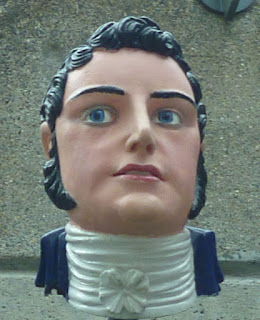Could this be Mr
Darcy?
My first thought was: it’s Mr Darcy! The hair, with the long
sideburns, dates from about 1813, as does the cravat. It’s the right date, and,
of course, he just looks right.
Hiawatha
The selection of figureheads is interesting, and indicates a
as a wide general knowledge on the part of those who named the ships. Some of the figureheads are from literature, like Hiawatha,
dating it to around 1855 when Longfellow’s narrative poem on the American
Indian hero was published and became a hit.
Diana
This is an unnamed classical female figure, who I think
must be the Roman goddess Diana – she has a crescent moon in her hair which is
one of Diana’s attributes.
Zenobia
There is also a figurehead labelled Zenobia, a powerful and
ambitious woman who became Queen of Palmyra in 267 AD. Whoever named his ship
after her was obviously a lover of the Classics.
Sir Lancelot (left) and Omar
Pasha (right)
There are figureheads of literary heroes closer to home,
too. Sir Lancelot, in his silver armour, somehow manages to look simultaneously both Medieval
and Victorian. He, too, has a literary provenance: Alfred, Lord
Tennyson’s Idylls of the King, a
series of narrative poems telling the story of King Arthur, was immensely
popular in the 1850s. Lancelot, who had sworn fealty to King Arthur, had an
adulterous affair with Guinevere, King Arthur’s wife. Tennyson sums him up,
unforgettably:
His honour rooted in
dishonour stood,
And faith unfaithful
kept him falsely true.
Next to Sir Lancelot is the dashing Omar Pasha (1806-71). He
was born a Serbian Christian but converted to Islam and became famous as an Ottoman
general, winning several spectacular victories over the Russians during the
Crimean War. The Turks were British allies during the war and Omar Pasha
was much admired.
Giuseppe Garibaldi
(1807-1882)
Other foreign heroes are represented, too, for example the politician
and fighter for Italian Unification, Giuseppe Garibaldi – another fine figure
of a man.
Florence Nightingale
(1820-1910)
Female contemporary heroines are not forgotten with Florence
Nightingale, ‘the lady with the lamp’; a figurehead which, in my opinion, doesn’t
do her justice.
Duchesse
The beautiful Duchesse is one of my favourites. Who was she?
French, obviously, but who? I thought that she might represent a French royal
mistresses, Madame de Pompadour, for example. But Madame de Pompadour was a
marquise, not a duchesse; the figure doesn’t look like her, and her hair isn’t
powdered, as la Pompadour’s hair would have been.
But, back to Mr Darcy. Alas, I doubt whether it is him; the figureheads
of literary heroes are men of action, like Hiawatha. Could it be Lord Byron? He
was certainly well-known (or notorious) enough and famous for his good looks as
well as his poetry.
Any suggestions?
Elizabeth Hawksley
Photos by Elizabeth
Hawksley









2 comments:
Great post, love the pictures! Not sure about Darcy but he is definitely a good-looking fellow, certainly a Regency dandy! Interesting that there are so many male figureheads, one tends to think that they would have been mainly females.
Also very timely post for me, Elizabeth, as I have been working on a short story featuring a ship's figurehead, rescued after a shipwreck. This is the boost I needed to finish it!
Thank you, Melinda/Sarah. I'm delighted if my post has inspired you to finish your short story! I, too, was surprised that there were so many male figureheads. They come, as I said, from merchant ships, rather than Royal Navy ships. That may make a difference. I can't see a Royal Navy ship being named after a contemporary hero like Garibaldi or Omar Pasha, for example. I doubt the Foreign Office would have approved, for a start!
Post a Comment